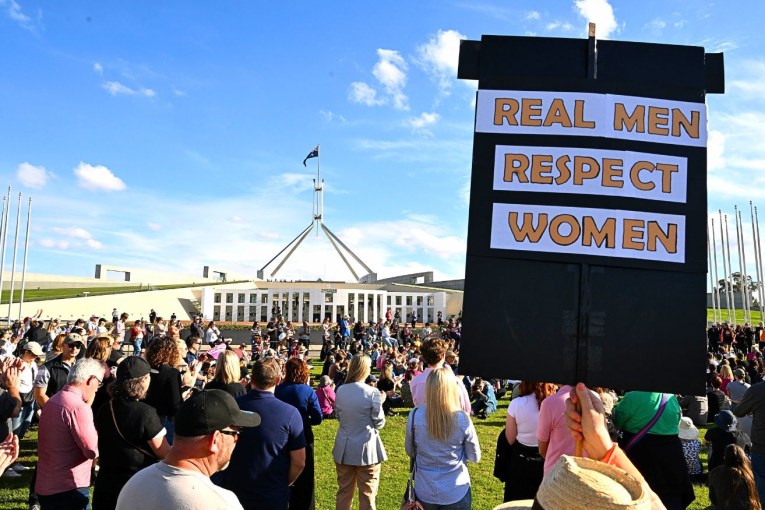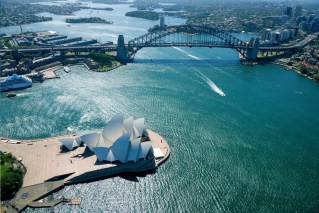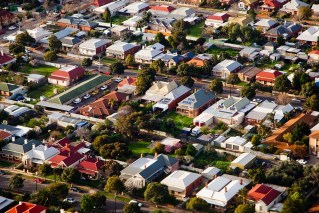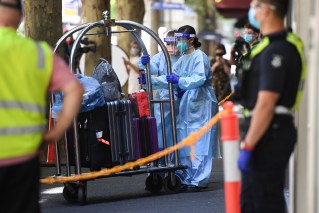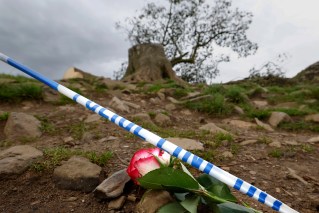Queen Elizabeth II dies peacefully, age 96, after more than 70 years on the throne

Britain’s longest-reigning monarch Queen Elizabeth II has died “peacefully”, age 96, bringing an end to the Elizabethan era which lasted more than 70 years.
Buckingham Palace confirmed the Queen passed away at Balmoral Castle in Scotland on Thursday afternoon (local time) after doctors had recommended she remain under medical supervision.
“The Queen died peacefully at Balmoral this afternoon,” the palace statement read.
“The King and The Queen Consort will remain at Balmoral this evening and will return to London tomorrow.”
Queen Elizabeth is survived by her four children, eight grandchildren and 12 great-grandchildren.

A member of royal household holds a notice at Buckingham Palace announcing the death of Queen Elizabeth II. Photo: Getty
The crown now passes to her eldest son, Charles, 73, who will be known as King Charles III. His wife Camilla becomes Queen Consort.
The new king released an official statement about losing his “beloved Mother” which was “a moment of the greatest sadness for me and all members of my family”.
“We mourn profoundly the passing of a cherished sovereign and a much-loved mother,” the statement said.
“I know her loss will be deeply felt throughout the country, the Realms and the Commonwealth and by countless people around the world.
“During this period of mourning and change, my family and I will be comforted and sustained by our knowledge of the respect and deep affection in which the Queen was so widely held.”
The Queen’s family rushed to be by her side at her Scottish home after doctors expressed concern about her health in recent days.
Charles was joined by the monarch’s other children the Princess Royal, the Duke of York and the Earl of Wessex, and the Duke of Cambridge, now heir to the throne.
Also at Balmoral are Camilla — the new Queen Consort — and the Countess of Wessex.
It’s reported the Queen’s grandson Prince Harry was travelling to Scotland while his wife Meghan stayed in England but may join him later.

Working in her last days, the Queen met Britain’s Prime Minister-elect Liz Truss at Balmoral Castle this week. Photo: Getty
Since the end of last year, the Queen had been suffering from what Buckingham Palace called “episodic mobility problems” which forced her to withdraw from nearly all her public engagements.
But determined to carry out her duties to the end, the Queen only two days earlier conducted the swearing-in of the UK’s new Prime Minister Liz Truss.
Ms Truss addressed a “devastated” nation outside Downing Street on Friday morning (local time) and paid tribute to the royal stalwart who was the “rock on which modern Britain was built”.
“Our country has grown and flourished under her reign. Britain is the great country it is today because of her,” she said.
Ms Truss hailed the ushering in of a new era under Charles by declaring “long live the King”.
Britain in mourning
The Queen’s death has plunged Britain into an official period of mourning which will officially continue until a funeral is held.
It’s reported her body will first be taken from Balmoral to the Scottish capital Edinburgh for ceremonies before making the final journey to London where she will lie in state in Westminister Hall.
The funeral arrangements — codenamed London Bridge — have long been planned in consultation with the government.
The UK government is expected to confirm the length of national mourning, which is likely to be around 12 to 13 days.
The Queen’s state funeral is expected take place at Westminster Abbey in central London.
Her final resting place will be the King George VI memorial chapel, an annex to the main chapel — where her mother and father were buried, along with the ashes of her sister, Princess Margaret.
Philip’s coffin will move from the Royal Vault to the memorial chapel to join the Queen’s.

A sea of mourners outside the gates of Buckingham Palace. Photo: Getty
World leaders react
World leaders paying tribute to the Queen have recalled their personal encounters the head of state with great affection.
Australia’s Prime Minister Anthony Albanese issued a lengthy statement hailing the monarch who “held a special place in her heart for Australia” after visiting 16 times.
“There is comfort to be found in Her Majesty’s own words: “Grief is the price we pay for love.”
“This is a loss we all feel, for few have known a world without Queen Elizabeth II.
The Prime Minister's statement on the passing of Her Majesty Queen Elizabeth the Second. pic.twitter.com/P6l00TQkId
— Anthony Albanese (@AlboMP) September 8, 2022
“She celebrated our good times, she stood with us in the bad. Happy and glorious but steadfast too.
“In particular, we recall the sympathy and personal kindness she extended to Australians afflicted by tragedy and disaster,” said Mr Albanese.
In the coming days the prime minister will travel to London with Governor-General David Hurley to convey the sorrow of Australians.
US President Joe Biden said the Queen “charmed us with her wit, moved us with her kindness, and generously shared with us her wisdom”.
French President Emmanuel Macron said: “I remember her as a friend of France, a kind-hearted queen who has left a lasting impression on her country and her century.”
Canadian Prime Minister Justin Trudeau said Queen Elizabeth was one of his favourite people in the world.
“I will miss her so.”
Crowds have been flocking to Buckingham Palace to lay flowers for the unwavering head of state who had been a constant in their lives for decades.
The Queen was also the world’s oldest and longest-serving head of state, after coming to the throne following the death of her father King George VI on February 6, 1952, when she was just 25.
She was crowned in June the following year.
Elizabeth became monarch at a time when Britain still retained much of its old empire.
It was emerging from the ravages of World War II, with food rationing still in force and class and privilege still dominant in society.
Winston Churchill was Britain’s prime minister at the time, Josef Stalin led the Soviet Union and the Korean War was raging.
In the decades that followed, Elizabeth witnessed massive political change and social upheaval at home and abroad.

The Queen with one of her corgis in 1952. Photo: Getty
Her own family’s tribulations, most notably the divorce of Charles and his late first wife Diana, were played out in full public glare.
While remaining an enduring symbol of stability and continuity for Britons at a time of relative national economic decline, Elizabeth also tried to adapt the ancient institution of monarchy to the demands of the modern era.
Elizabeth was the 40th monarch in a royal line that followed Norman King William the Conqueror, who claimed the English throne in 1066 after defeating Anglo-Saxon ruler Harold II at the Battle of Hastings.
Her long reign meant she repeatedly broke records for British rulers.
When she surpassed the more than 63 years her great-great-grandmother Queen Victoria spent on the throne, she said it was not a landmark to which she had ever aspired.
“Inevitably a long life can pass by many milestones — my own is no exception,” she said.

Princess Elizabeth and The Prince Philip, Duke of Edinburgh married in 1947. Photo: Getty
Her marriage to Prince Philip lasted 73 years, until his death in April 2021, and they had four children, Charles, Anne, Andrew and Edward.
She never gave a media interview and critics said she came across as distant and aloof.
But for the vast majority of her subjects, for whom she was the only monarch they have known, she was a figure who commanded respect and admiration.
Her death marks the end of an era.
-with AAP
